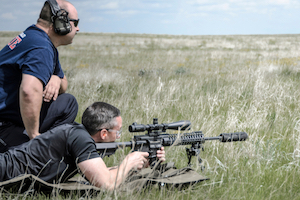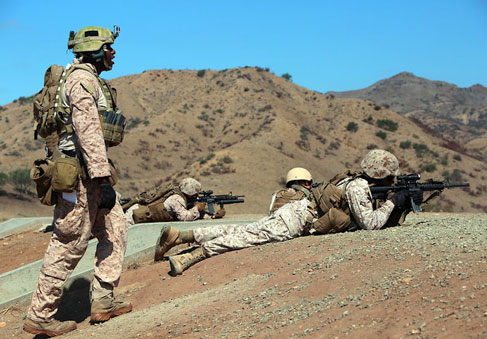Marksmanship requires you to align your sight on the target, maintain stability, control your breathing, and manage your fine-motor skills to pull the trigger without moving off the target. High levels of anxiety can make it hard to perform well at these tasks and impact your marksmanship performance. The good news is that there are things you can do to help manage anxiety and improve your score.
The moments when your marksmanship performance matters the most can be quite stressful. Whether you’re in an actual firefight or taking part in the new combat-focused marksmanship qualification, it’s expected that your stress-response system will be activated. This isn’t necessarily bad because your stress-response system is designed to give you the energy to effectively deal with threats. Your body releases stress hormones and energy to help you prepare to fight or flee the threat. Your breathing, heart rate, and blood pressure increase too, which can cause you to shake or have less control over your fine motor skills. This makes it hard to hold a weapon steady, which is critical for marksmanship performance.
Here are two skills you can use to help boost your ability to manage stress and improve your marksmanship performance.
Imagery
 “Practice makes perfect” is true for marksmanship as it is for any skill. Imagery enables you to practice even when you’re off the range. It’s rehearsing a performance in your mind, scripting out what you’d see, hear, taste, and smell as you overcome challenges. Imagery also will help you develop your skills and feel less stress and anxiety when it’s crunch time. When you create vivid and detailed imagery of your high-pressure environment and then visualize yourself calmly and successfully executing your marksmanship training, you’ll feel more confident and prepared.
“Practice makes perfect” is true for marksmanship as it is for any skill. Imagery enables you to practice even when you’re off the range. It’s rehearsing a performance in your mind, scripting out what you’d see, hear, taste, and smell as you overcome challenges. Imagery also will help you develop your skills and feel less stress and anxiety when it’s crunch time. When you create vivid and detailed imagery of your high-pressure environment and then visualize yourself calmly and successfully executing your marksmanship training, you’ll feel more confident and prepared.
One way to practice imagery is to create an imagery script. To better handle stress and improve your marksmanship performance, use HPRC’s “Building an Imagery Script” worksheet. Or take a look at the sample imagery script for basic rifle marksmanship (BRM) training below.
You’re at the range about to engage in BRM training. Settling in the prone position, you’re about to fire your M16 in single-shot bursts. You feel your weapon in your hands and anchor your body properly against the ground. Looking ahead, you see the target in your rifle sights at 50 meters. You hear your peers on the firing line. In about 60 seconds, your event will start. You notice how you think and feel in this moment. You feel nervous in your ability to execute your best performance today. And you experience the familiar tension in your muscles and increased heart rate as the time to perform draws closer. At first, you think about missing the target and not qualifying, but you remember how to refocus: “Breathe, Relax, Aim, Squeeze.” These thoughts and feelings tell you that you’re ready to start. In the past, you experienced these thoughts and feelings and performed well. Today’s performance matters, and you’re feeling confident in your ability to do well. Your breathing and attention are calm and controlled. Nothing can affect you today. Your platoon sergeant gives the command, “Fire when ready.” You take a slow, centered breath. Prior to your trigger squeeze, you sight your target, deeply inhale, position your finger over the trigger, and exhale fully… 3, 2, 1. You squeeze the trigger and see the bullet strike the target exactly where you aimed. Firing your weapon feels effortless. You continue firing rounds with the same level of focus and calm, taking each shot one at a time as you execute your technique effectively. You finish your event and acknowledge your good performance. You also reflect on the nerves you felt at the start of the event. Your muscle tension and increased heart rate before starting helped you perform your best today. You’re confident in your ability to refocus in the moment and recognize that these nerves are important in helping you perform successfully. And you understand that this routine is going to lead to good performances in the future.
Breath control
Controlling your breath is critical for marksmanship. When you breathe, your body moves, which can impact your accuracy. So, it’s important to try to fire during the natural respiratory pause (those 2–3 seconds in between exhaling and inhaling). When the stress response is activated, your breathing speeds up and can become irregular. One strategy that’s often used is to force yourself to stop breathing when firing. This can be very effective, but losing too much oxygen can make you light-headed, undermine your sight alignment, and tighten your muscles. You can also use controlled breathing to help pump the brakes on your stress response, so you’ll feel more relaxed and in control.
When you’re preparing to shoot or even while you’re shooting, you can practice controlling your breath. Try “box breathing” to calm your stress response:
- Inhale slowly for a count of 1…2…3, filling your abdomen with air first, then your lungs, and then your chest.
- Hold for a count of 1…2…3.
- Exhale through your nose, releasing the air from your chest, lungs, and abdomen for 3…2…1.
- Hold for a count of 1…2…3.
- Repeat steps 1–4 at your own rhythm for 2 minutes.
Bottom line
Your time on the range might be limited, but you can practice imagery skills and controlled breathing anytime to reduce stress, improve your marksmanship, and boost your overall performance. In addition, watch HPRC’s video below to learn more about how belly breathing can enhance your well-being and help you perform at your best.

